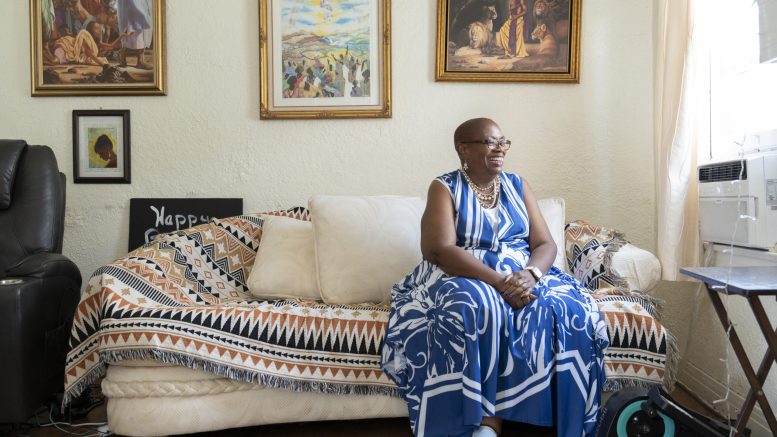California program helps patients navigate the complexity of early Alzheimer’s and dementia care.
By George B. Sánchez-Tello, Capital & Main
This story is produced by the award-winning journalism nonprofit Capital & Main and co-published here with permission.
In September, the Rev. Carolyn Habersham began to notice things misplaced or missing around her home. Her debit and credit cards ended up in her make up box. Then her make up kit disappeared. One day she was cooking and went to get her phone. She forgot why she needed her phone. And she forgot about the food on the stove.
“It traumatized me when I walked into the kitchen and there’s a pot I completely forgot about,” said Habersham. “It shook me to my core.”
As a cancer survivor, Habersham, 72, learned the importance of self-advocacy, especially as a Black woman who has lived without health insurance for much of her life. Now receiving Medicare, she met with her primary care physician and a neurologist in November. The neurologist told her she has mild cognitive impairment, a warning sign for Alzheimer’s and dementia.
Habersham is a model of the kind of self-advocacy that is important in the early stages of memory loss. Our health system often lacks a clear path to diagnosis and treatment.
Alzheimer’s experts say dementia care is a maze that encompasses primary care providers, specialists, the scheduling of tests, medicine management and support for caregivers.
“You cannot deal with something if you don’t know what you’re dealing with,” Habersham said. “It feels like I’m being trapped in a place I should be able to get out of but I can’t because you won’t give me the key.”
Improving dementia care may be as challenging as finding a cure, warned a Rand Corporation study seven years ago. Dementia care improvements will require “solving a complex puzzle” including more disease testing and screening; more doctors, nurses and specialists; and more home-based treatments.
In the meantime, patients like Habersham and their caregivers are often left to navigate Alzheimer’s and other forms of dementia largely on their own.
“Advocates are probably the most crucial thing for seniors, particularly in navigating the health care system,” Habersham said.
Alzheimer’s and dementia will dramatically increase in the coming years. But Alzheimer’s and dementia disproportionately affects communities of color — particularly Blacks and Latinos — in the United States and California. The rate at which Blacks in the state succumb to the degenerative brain disease is greater than that of their peers. Los Angeles County is one of the nation’s epicenters of dementia among Blacks.
In California, researchers, doctors and public health workers have developed models to better serve people with dementia, or PWD. Habersham has largely relied on Alzheimer’s Los Angeles, an organization that provides education and direction to people living with Alzheimer’s. After meeting with her doctors in November, she attended Alzheimer’s Los Angeles’ Early Memory Loss conference in January. The conference led her to a support group for people with dementia.
Through all this she has worked with Cassandra Rivera, a social worker who oversees Alzheimer’s Los Angeles’ care counseling program, which offers personalized guidance. Rivera was able to cut through the reams of research on Alzheimer’s and dementia to provide Habersham with tailored information on early memory loss signs and symptoms. Rivera affirmed Habersham’s experience of visuospatial difficulties — the inability to recognize objects in front of her.
When Habersham saw a neurologist who was dismissive of her memory loss, telling her that in time her brain might fix itself, Rivera and staff at Alzheimer’s Los Angeles helped her to find another neurologist.
Alzheimer’s Los Angeles classes have helped Habersham plan for the changes in her life. A pastor at First Presbyterian Church of Los Angeles, Habersham now runs her Bible study and prayer groups by Zoom from home. Her food is delivered; she doesn’t allow herself to cook. She gave away her car and won’t drive to ensure she doesn’t accidentally harm anyone.
Many of the people that have helped Habersham have noted that she is an example of the positive result of effective public education and outreach: a patient who is informed and able to self-advocate. Yet education and self-advocacy can go only so far if health care systems have not adjusted to better serve the needs of their patients.
“I made a conscious decision yesterday that I’m not going to live with dementia; dementia is going to live with me,” Habersham said the first time we met.
According to her paperwork, she isn’t living with dementia yet. The second neurologist could formally diagnose Habersham. Meanwhile, doctors and social workers recognize the early signs of dementia in her. Habersham doesn’t have time to wait. Her father, the Rev. Ezekiel Habersham, died of the same disease in 2013 at the age of 87.
The health care system needs to learn from patients like Habersham and move with the same urgency to serve people with Alzheimer’s and other forms of dementia.
Copyright 2024 Capital & Main.


Be the first to comment on "‘I’m not going to live with dementia; dementia is going to live with me’"